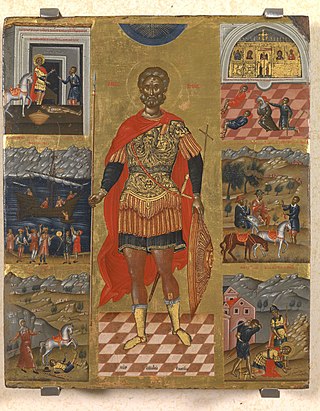
Cretan school describes an important school of icon painting, under the umbrella of post-Byzantine art, which flourished while Crete was under Venetian rule during the late Middle Ages, reaching its climax after the fall of Constantinople, becoming the central force in Greek painting during the 15th, 16th and 17th centuries. The Cretan artists developed a particular style of painting under the influence of both Eastern and Western artistic traditions and movements; the most famous product of the school, El Greco, was the most successful of the many artists who tried to build a career in Western Europe, and also the one who left the Byzantine style farthest behind him in his later career.

Theophanis Strelitzas, also known as Theophanes the Cretan or Theophanes Bathas was a Greek painter of icons and frescos in the style of the Cretan School. He passed much of his career as a member of the monastic community of Mount Athos.

Andreas Pavias was a Greek painter and educator, one of the founding fathers of the Cretan School. His works could be found in churches and private collections throughout Italy and Greece, where they influenced countless artists. Seven of these paintings survive today, six bearing Pavias's signature. The most famous of the group is a Crucifixion.

Frantzeskos or Franghias Kavertzas was a Greek painter. His painting style resembles the late Cretan School or early Greek Baroque period. His work was influenced by Georgios Klontzas, Michael Damaskinos and Emmanuel Tzanfournaris. He was active in Crete during the early part of the 17th century roughly after the death of Georgios Klontzas. He painted two icons that are very similar to Klontzas's most notable pieces. Theodore Poulakis also painted similar themes. Kavertzas artwork incorporates the Venetian school. His works influenced Leos Moskos. His most notable works are the Last Judgement, In You Rejoiceth.
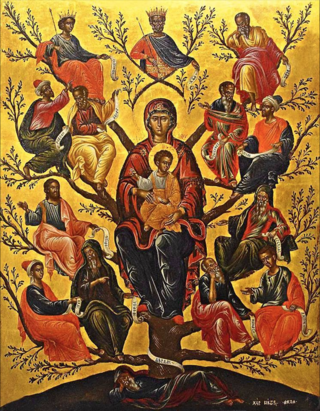
Victor was a painter active during the 17th century. He represented the late Cretan school. He was influenced by Michael Damaskinos. He kept his style simple and followed the lines of the improved maniera greca which was heavily influenced by the Venetian school. One of his main influences was Michael Damaskinos. He was active when four different artists used the name Victor. He has a huge catalog of work attributed to him. According to the Neo-Hellenic Institute, ninety-five of his paintings and one fresco survived. He was an extremely popular Greek icon painter.
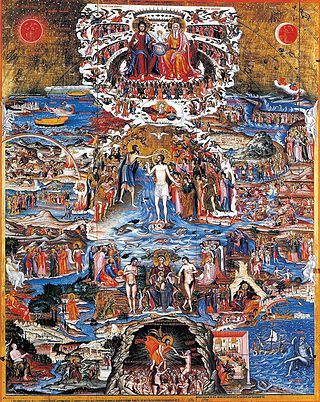
Ioannis Kornaros was a Greek painter. He was one of the few painters from Crete during the 19th century. He does not belong to the Cretan Renaissance but was influenced by the art. He is considered to be one of the foremost icon painters of the Greek Neoclassical era and Modern Greek Enlightenment in art also known as Neo Hellenikos Diafotismos. He implemented a unique style. He was influenced by Michael Damaskinos, Georgios Klontzas, Victor and other Cretan artists. He influenced Modern Greek art. He is one few Greek painters affiliated with Cyprus. Others included Ioannis Kyprios and Theodore Apsevdis. His teacher was Georgios Kastrofylakas. His most famous painting Great Art Thou resembles Georgios Klontzas's In Thee Rejoiceth.

Georgios Kastrofylakas (Greek: Γεώργιος Καστροφύλακας, 1699/1705 – 1760/1770), also known as Georgios Kastrofylax or (Zorzis). He is one of the few Greek painters that remained in Crete. Others included Ioannis Kornaros. Kornaros was his student. Kastrofylakas followed the lines of the Cretan School. His work was influenced by legendary artists such as Georgios Klontzas, Michael Damaskinos and Angelos. Historians argue Kastrofylakas had many students due to the resemblance of his work. He belongs to the Neo-Hellenikos Diafotismos in painting and the Greek Rococo period. He influenced countless Greek iconographers. Thirty-six paintings are attributed to Kastrofylakas. The artist added more realism to his paintings. Most of his artwork is in Heraklion, Crete. His most notable work is the Adoration of the Magi.

Nicholas Ritzos also known as Rizo and Ricio). He was a Greek Renaissance painter. His father was famous painter Andreas Ritzos. His brother was painter Thomas Ritzos. His son was painter Manea Ritzos. Nicholas and his father Andreas Ritzos are the forefathers of the Cretan School of painting. They influenced countless artists both Greek and Italian. There painting style was the typical Venetian influenced maniera greca in Crete. The island transitioned from the classical Byzantine painting to a more refined style. His contemporaries were Andreas Pavias, Nikolaos Tzafouris, and Angelos Akotantos. They influenced painters such as Michael Damaskinos, Petros Lambardos, and Emmanuel Lambardos. Nine of his works have survived.

Ieremias Palladas, also known as PouladasIeremia Pallada. He was a Greek Renaissance painter. He was a clergyman, painter, and educator. He was affiliated with Saint Catherine's Monastery in Mount Sinai, Egypt. He is one of the most notable Greek painters of the 17th century. His family consisted of clergy and painters. His nephew was Patriarch of Alexandria Gerasimos Palladas. His work was influenced by Nikolaos Tzafouris and Angelos Akotantos. Georgios Klontzas and Emmanuel Lambardos were active in Crete around the same period. Palladas influenced the works of Theocharis Silvestros, Iakovos Moskos, Ioannis Kornaros and Philotheos Skoufos. According to the Institute of Neohellenic Research, twenty-four of his works survived. His specialty was painting crosses for the iconostasis or templo. Most of his works are in Egypt.
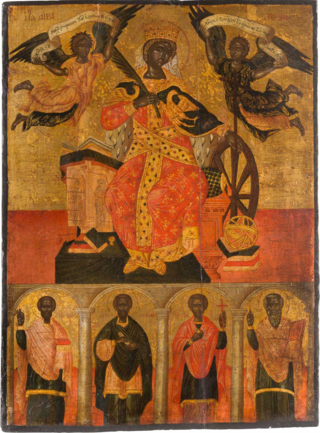
Theocharis Silvestros was a Greek Baroque painter. He was a monk affiliated with Saint Catherine's Monastery Mount Sinai, Egypt. He was also active in Heraklion Crete. He was influenced by famous painters Emmanuel Lambardos and Ieremias Palladas. Theocharis was a renowned painter of the Cretan School. He influenced countless Greek painters. He was active during the same period as Philotheos Skoufos and Franghias Kavertzas. His most notable works are of Catherine of Alexandria. Most of his remaining works are associated with Saint Catherine's Monastery Mount Sinai, Egypt. He was a Sinaitic monk.

Konstantinos Paleokapas was a Greek painter active during the 17th century. He was active in Crete. His contemporaries were: Elias Moskos, Leos Moskos, Victor (iconographer), Franghias Kavertzas and Ieremias Palladas. His style was similar to his contemporaries, the artists were part of the Cretan School. The art was heavily influenced by Venetian art. His remaining work testifies to the style of the region. Six of his works have survived. His most notable work is the Crucifixion of Christ. His Crucifixion is comparable to the Ioannis Moskos Crucifixion and The Crucifixion (Pavias) by Andreas Pavias. His Crucifixion lacks the unique Impenitent thief found in many followers of Pavias's style. His Crucifixion mostly resembles Ioannis Moskos. Paleokapas had a unique style. Most of his work is at the Gonia Monastery in Crete.
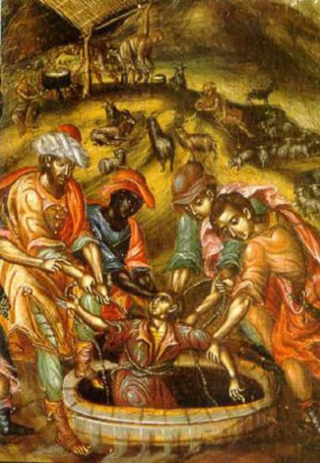
Neilos, also known as Neilos Kokolitza was a Greek painter, monk, and archbishop. He was the Archbishop of Kea and Thira. He was a prominent member of the Cretan School. His contemporaries at the time were Ieremias Palladas, and Theocharis Silvestros. He influenced the works of countless Greek and Italian artists. He is one of few Greek painters who had a high rank within the church. Another hi ranking Greek painter was Archpresbyter Andreas Karantinos. Several of his works have survived and they can be found in the museum of Gonia Monastery. His most popular work is The Story of Joseph.

Georgios Kortezas, also known as Tzortzis Kourtezas. He was a Greek baroque painter. He was a member of the Cretan School. He was from a wealthy family. Notable Greek painters active during the same period were Georgilas Maroulis, Ieremias Palladas and Theocharis Silvestros. His style was the Venetian influenced Greek mannerism with some Byzantine influence characteristic of Cretan art. Three of his works survived. The Tragedy of Saint Demetrios. The painting is at the Benaki Museum. The Archangels Gabriel, Micheal, and Raphael. Poli Museum, Corfu. Finally, George Slaying the Dragon is part of the Provatorov Collection in Geneva.

Iakovos Moskos or Moschos was a Greek painter. He shared the same name as three other famous Greek painters Ioannis Moskos, Elias Moskos and Leos Moskos. He was affiliated with Saint Catherine's Monastery. Moskos painted in the typical Greek style. He was active during Greek Rococo and the end of the baroque period in Greek art. Ioannis Kornaros was exposed to his work while he was at the monastery. He was known for painting the Holy place of Mount Sinai the assumed location where Moses received the commandments. It is his most notable work. Eight of his paintings have survived.

The Crucifixion is a tempera painting by Konstantinos Paleokapas. Paleokapas was a Greek painter from the island of Crete. He was active during the early part of the 1600s. Six of his works survived, four are signed. The Crucifixion is one of the most popular events in human history. The scene has been duplicated countless times. Many crucifixion paintings were created by painters from the island of Crete. Some painters included El Greco, Andreas Pavias, Georgios Markazinis and Ioannis Moskos. Paleokapas created his own version of the popular subject. His crucifixion painting followed the prototype of many other paintings thematically. He added both the dice players and the resurrection of the dead. Andreas Pavias’s The Crucifixion (Pavias) and Margkazinis’s The Crucifixion (Margkazinis) both feature the popular pictorial representation of Mathews gospel. Paleokapas’s Crucifixion is located at the Gonia Monastery in Crete.

Catherine of Alexandria is a tempera painting created by Ieremias Palladas. Palladas was a monk associated with Saint Catherine's sacred monastery in Egypt also known as Mount Sinai. He was a painter and teacher. His nephew became the Patriarch of Alexandria. His name was Gerasimos Palladas. Ieremias was a Sinaitic monk because of his association with Saint Catherine's monastery on Mount Sinai. The monastery encloses the site where it is assumed by Christians that Moses saw the burning bush. Ieremias was one of the most influential figures of his time. The Patriarch of Jerusalem Nectarius wrote about the painter in his archives.

The Virgin of the Burning Bush was a painting made of egg tempera and gold leaf on a wood panel. The portable icon was signed by Greek painter Michael Damaskinos. Damaskinos has over 100 known works. He was a distinguished member of the Cretan school of painting. He was from Crete. His contemporaries included Georgios Klontzas and El Greco. Damaskinos spent over twenty years traveling all over Italy. He spent a significant time in Venice. He adopted Italian artistic mannerisms which he applied to his paintings.

Nikolaos Gripiotis aka Nicolò Gripioti, was a Greek painter and teacher. He was a prominent member of the Cretan School in the early 1500s, working alongside such practitioners as Michael Fokas and Giorgio Miçocostantin. No work survives bearing his signature, but documents from the period record thousands of icons produced by his workshop. Nikolaos's son Ioannis Gripiotis also became a prominent painter. The family was related by marriage to Arsenius Apostolius.

Transfiguration and Monastic Scenes is a multi-themed tempera painting created by Greek painter Georgios Klontzas. Klontzas was a Cretan Renaissance painter. The artist was hired to assess work completed by El Greco. Klontzas was from a wealthy family and owned a successful workshop in the center of Crete. His existing catalog consists of Fifty-four works. He completed incredible triptychs and manuscripts. Klontzas and Micheal Damaskinos are two of the most prominent Greek painters of the 16th century due to the size of their catalogs and the popularity of their works excluding El Greco.

Christ Pantocrator is a tempera painting created by Ieremias Palladas. Ieremias was associated with Saint Catherine's sacred monastery in Egypt also known as Mount Sinai. He was a Sinaitic monk, painter, and teacher. His nephew Gerasimos Palladas became the Patriarch of Alexandria. There was a dependency of Saint Catherine's Monastery which was in Mount Sinai, Egypt on the island of Crete which was called Saint Catherine's Monastery of Heraklion. The site in Egypt was believed by Christians to be the site where Moses saw the burning bush. The Patriarch of Jerusalem Nectarius wrote about the painter in his archives because Ieremias was one of the most influential figures of his time.



















